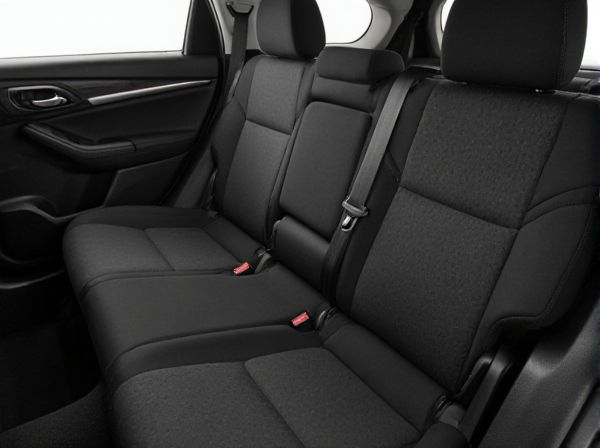
Photo illustration: Memory Foam Seat vs Traditional Foam Seat
Memory foam seats conform to your body, providing personalized comfort and superior pressure relief compared to traditional foam seats, which often feel firmer and less adaptive. The viscoelastic properties of memory foam enhance support and reduce discomfort during prolonged sitting, making it ideal for office chairs or car seats. Your overall seating experience improves with memory foam, promoting better posture and reducing fatigue.
Table of Comparison
| Feature | Memory Foam Seat | Traditional Foam Seat |
|---|---|---|
| Material | Viscoelastic memory foam | Polyurethane foam |
| Comfort | Contours to body for pressure relief | Firm support, less contouring |
| Durability | Maintains shape longer, resists sagging | Prone to wear and deformation over time |
| Temperature Sensitivity | Softens with body heat for better fit | Unaffected by temperature |
| Cost | Higher price point | More affordable |
| Support | Adaptive support reduces fatigue | Basic support |
| Weight | Generally heavier | Lighter weight |
Introduction to Memory Foam and Traditional Foam Seats
Memory foam seats utilize viscoelastic polyurethane that conforms to body shape, providing superior pressure relief and enhanced comfort compared to traditional foam seats. Traditional foam seats are typically made from polyurethane foam with open-cell structures, offering consistent support but less contouring ability. The unique density and slow recovery characteristic of memory foam result in better shock absorption and long-lasting comfort, making it ideal for seating applications requiring ergonomic design.
Key Differences: Memory Foam vs Traditional Foam
Memory foam seats contour to the body's shape, providing enhanced pressure relief and support, while traditional foam seats offer consistent firmness without conforming to individual body curves. Memory foam is viscoelastic, allowing it to absorb shock and reduce motion transfer, whereas traditional foam tends to be firmer and less responsive to weight distribution. Durability varies with memory foam generally lasting longer but sometimes retaining heat, while traditional foam is often more breathable but may degrade faster under heavy use.
Comfort Levels: Which Foam Offers Better Support?
Memory foam seats conform to the body's contours, providing superior pressure relief and customized support compared to traditional foam seats that often compress unevenly over time. The viscoelastic properties of memory foam distribute weight evenly, reducing discomfort and enhancing long-term sitting comfort. Traditional foam seats may feel firmer initially but tend to lose resilience, resulting in diminished support and increased fatigue during extended use.
Durability and Longevity Comparison
Memory foam seats offer superior durability compared to traditional foam seats due to their ability to retain shape and support over time, reducing sagging and indentations. Traditional foam seats tend to break down faster as the material compresses and loses resilience, often within a few years of regular use. High-density memory foam cushions provide longer-lasting comfort and structural integrity, making them a cost-effective investment for prolonged seating durability.
Pressure Relief and Body Conformity Analysis
Memory foam seats provide superior pressure relief by evenly distributing body weight and reducing pressure points compared to traditional foam seats, which tend to compress unevenly and create localized discomfort. The viscoelastic properties of memory foam enable better body conformity, allowing the seat to adapt closely to the user's shape and maintain spinal alignment. Traditional foam often lacks this adaptive quality, leading to less effective ergonomics and increased risk of pressure-related discomfort during prolonged sitting.
Temperature Regulation: Cooling vs Heat Retention
Memory foam seats excel in temperature regulation by incorporating gel-infused layers or open-cell structures that enhance airflow and dissipate heat, providing a cooling effect. Traditional foam seats typically retain more heat due to their dense, closed-cell composition, leading to increased discomfort during extended use in warm conditions. The advanced design of memory foam supports improved breathability, making it a superior choice for maintaining a comfortable seating temperature.
Allergen Resistance and Hygiene Factors
Memory foam seats offer superior allergen resistance compared to traditional foam seats due to their dense structure that inhibits dust mites and mold growth. Traditional foam seats, often more porous, tend to accumulate allergens and bacteria, increasing the risk of hygiene issues over time. Memory foam's hypoallergenic properties make it a preferred choice for users seeking enhanced cleanliness and reduced allergic reactions.
Price Comparison: Memory Foam vs Traditional Foam Seats
Memory foam seats typically cost 20-40% more than traditional foam seats due to higher quality materials and enhanced comfort features. Traditional foam seats are more budget-friendly, generally priced between $50 to $150, while memory foam options range from $75 to $250 or more depending on density and brand. Investing in memory foam can provide longer-lasting support and durability, potentially offsetting the initial higher price with better value over time.
Ideal Use Cases for Each Foam Type
Memory foam seats excel in providing superior pressure relief and contouring, making them ideal for long hours of sitting in office chairs or gaming setups where ergonomic support reduces fatigue. Traditional foam seats offer firmer support and better breathability, suitable for casual seating like dining chairs or benches where durability and quick recovery are essential. Choosing between memory foam and traditional foam depends on whether comfort and pressure distribution or structural support and airflow are prioritized in the seating environment.
Conclusion: Choosing the Right Seat for Your Needs
Memory foam seats provide superior pressure relief and contouring compared to traditional foam, making them ideal for prolonged sitting and comfort-focused users. Traditional foam seats often offer firmer support and greater durability, which suits those requiring robust seating solutions and cost-effectiveness. Selecting between memory foam and traditional foam depends on individual preferences for comfort, support, and intended usage duration.
 caratoz.com
caratoz.com